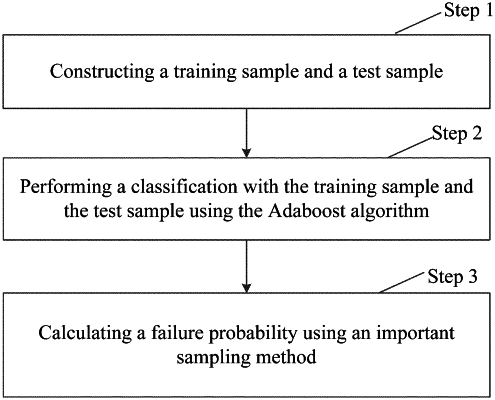| CPC G06N 20/20 (2019.01) [G06F 18/211 (2023.01); G06F 18/2415 (2023.01); G06F 30/23 (2020.01); G06F 30/27 (2020.01); G06N 7/01 (2023.01); G06T 17/20 (2013.01); G06F 2119/02 (2020.01)] | 1 Claim |

|
1. A method for evaluating reliability of a sealing structure in a multi-failure mode based on an Adaboost algorithm, the method comprising:
step 1, constructing a training sample and a test sample, wherein
when using elastic modulus, a Poisson's ratio, an oil pressure and a pre-compressed amount of an O-ring seal as features during an experimentation, and regarding that whether the sealed structure is failure after running 105 hours in a same load spectrum as a binary classification label, an experiment sample is produced, and a sample volume of the experiment sample is N; wherein parameters input are independent of each other and are approximated as following a normal distribution, 80% of the experiment sample are randomly selected as the training sample, and remaining 20% of the experiment sample are selected as the test sample;
step 2, performing a classification with the training sample and the test sample using the Adaboost algorithm, wherein
when using a binary classification algorithm of adaboostM1 in a Matlab toolbox, regarding a weak learner type as a decision tree, the training sample is classified for multiple rounds of training; a trained classification model is recorded as F(X), wherein X is an input feature vector of the O-ring seal, and if F(X)<0 in an input condition, the O-ring seal is deemed to be failure under the input condition; otherwise, the O-ring seal is non-failure;
step 3, calculating a failure probability using an important sampling method, wherein
the failure probability of O-ring seal is calculated using the important sampling method based on expanding variance, an expansion coefficient is set to be 1.05, N sets of data are extracted and recorded as Xi, wherein i is equal to 1, 2, . . . , N, and substituted into the trained classification model F(X), when F(Xi)<0, the O-ring seal under Xi is deemed to be failure;
the failure probability is calculated using a formula
 wherein in the formula i are all possible values that make F(Xi)<0 true, gcov is a joint probability density distribution function of a design parameter after expanding the variance, and fcov is the joint probability density distribution function of the design parameter before expanding the variance.
|